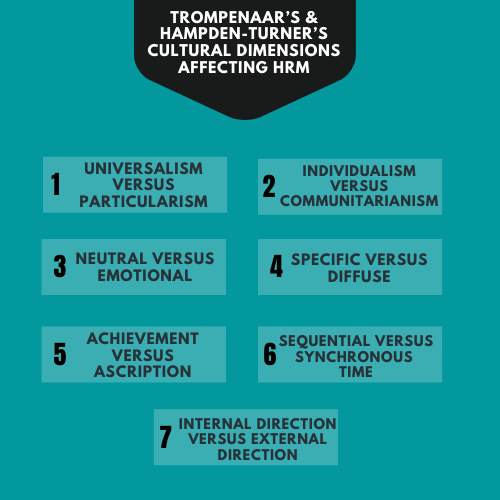Discussion On Hofstede's Cultural Dimension In India
Question
Task: You are the human resource manager of an international company in Australia. You have learned about a number of cross-cultural management studies, each with their own take or improvement on the dimensions or characteristics of culture. Pick a set from all the studies of the four dimensions which you find most relevant to HRM. Explain how each of your chosen dimensions would impact the human resource management of both expatriate managers and the host country nationals in your chosen foreign culture.
Answer
Introduction
The current report helps understanding the concept of Hofstede's cultural dimension. In the modern business environment, global ventures often face intercultural issues while operating in foreign land. In this study, the various effects of the cultural dimensions on the HRM policies of an Australia-based international organisation in India will be analysed.
How Hofstede’s cultural dimension affect HRM?
The Hofstede's cultural dimension affects the human resource policies of business organisations operating in India. The four major HR activities are recruitment and selection, training and development, compensation and performance management. Hofstede(2011) argued that each of the five cultural factors in Hofstede's cultural dimension model affects these HR activities uniquely depending on the country where the business organisation operates.

The power distance index is the factor that concerns with the level of tolerance that individual people in a culture shows towards the existing power hierarchy. In case of India, the power distance index positively affects HRM. This indicates that the recruitment for both expatriates and local managers in India must be done in such a way that more experienced and older employees get better chance. This will help the lower employees working in India to accept the organisational hierarchy easily. Training and development activities also must be carried out by older and more experienced trainers. Compensation should be handed out by the highest level of management to the employees, and performance management policies should emphasize on experience. Favarettoet al.(2016) argued that due to this, in India, local employees will easily follow expatriate managers, which will enhance the business efficiency of the organisation. The factor of uncertainty avoidance positively affects the HRM policies in India. Thus, recruitment and selection activities as well as training and development activities should be carried out in a systematic manner in India. The policies and criteria for rewarding excellent employees with compensation should also be clearly stated to all employeesbeforehand, and company should have a clear performance management policy that will not differentiate between expatriates and local managers.

The factor of individualism versus collectivism affects the HRM policies negatively in India. This is because Indian employees preferto show a collectivistic tendency in their life. Thus, Beugelsdijk,Kostova& Roth(2017) argued that the recruitment and selection processshould be designed in such a way that it allows more cultural interactions between the expatriate managers and local employees. The training of local employees should also be preferably done by local trainers. The compensation structure should also be the same for both the expatriate and local managers or employees, otherwise discriminatory situation may arise. Furthermore, performance management standards should also be followed in an unbiased manner.
The factor of assertiveness affects the HRM policies negatively, as in terms of assertiveness India is much lower than Australia. Thus, the activities of recruitment and selection as well as training and development should be carried out in a less assertive way for Indian employees. The compensation policies and performance management policies should also be designed accordingly. However, these could be done in a more assertive way for expatriate managers.Minkov(2018) argued that the performance orientation is a factor that affects the HRM activities positively in India, as in the modern age, Indian work culture is gradually becoming performance-oriented. Thus, the recruitment and selection as well as training and development activities should be done while focusing on performance for both expatriates and local employees. The compensation should be given based on performance, and performance management policies should only focus on the overall workforce efficiency of the organisation in India.
GLOBE’s eight cultural dimensions affecting HRM
Mansouret al.(2019) argued that as many of the factors in Globe's cultural study is similar to that of Hofstede's cultural dimension, the factors affect the HRM policies in India in a similar manner. For instance, as argued before, the power distance index, the uncertainty avoidance and performance orientation affect the HRM policies in India positively, while the lack of assertiveness affects the HRM policies in India negatively.However,McSweeney(2016) argued that in terms of both the institutional collectivism and in-group collectivism, India has a high score which indicates that it affects HRM activities positively. This is because in terms of recruitment and training activities a collectivistic approach can be taken in India for both expatriates and local employees using intercultural communication. Pagda(2019) argued that performance management and compensation strategies could take a similar approach. Furthermore, in terms of future orientation India is not very high which indicates that it affects the HRM activities negatively. Finally, in India the human moral qualities are given great importance, which indicates that this affects the HRM policies positively. For instance, Venaik& Brewer(2016) argued that the recruitment, training and performance management activities can be done while giving everylocal and expatriate equal employee importance, and the compensation policies can be executed in an unbiased manner, enhancing the sustainability of the international organisation in India.
Trompenaars & Hampden-Turner’s cultural dimensions affecting HRM

- Universalism versus Particularism: According to the universalist culture the difference between right and wrong should be always same in all situation . Values and ethics are important and employees should not deviate from them in any situation. On the contrary in the particularistic culture, the employees believe that it is the circumstances that determine how the ideas can be implemented. Moreover it is the personal obligations and relationships that can affect ethical decisions.
- Individualism versus Communitarianism: The idea of individualism believed that human beings are individual whereas according to communitarianism, humanity is a huge group (Maduagwu & Igwe, 2018). The ideas of the Western world practiced belong to the individualist culture; however, communitarian culture is connected to the non-western countries. According to the former concept, the culture changes continuously according to the changes of human Civilization.
- Neutral versus Emotional: Neutral emotion can be controlled whereas in the emotional culture, spontaneous expressions are accepted. In some countries, loud expressions are prohibited in the workplace whereas in the other countries they are not. Therefore it can affect the human resource management system in case of the expatriate workers.
- Specific versus Diffuse: In some specific culture, the individuals are allowed to access a large public space where they can share things with each other. Informal culture can be practiced here. On the contrary, in a diffuse culture, people protect their private spaces and distinguish it with their public spaces are working environment. Such culture can affect the human resource as it is not easy for the managers to identify people who believe in such cultures.
- Achievement versus Ascription: Achievement and ascription, developed here. Sometimes people can belong to the achievement oriented culture and their worth can be determined through the performances (Lichy & Stokes, 2018). On the contrary, an ascription-oriented culture prefers the well informed people who know the use of skills and knowledge rather than the people from achievement oriented culture. Often in an organisation, a mix of these cultures can be found. Hence, the conflicts among the employees can generate and affect the human resource management system.
- Sequential versus Synchronous time: The measurement of time can be different for many organisations. Mostly the organisations believe in the worth of time in terms of money. However in case of synchronous time, the ability of the employees to work on various projects at the same time is measured as the time of working of an employee. However the HRM System organisations need to ensure the practice that they believe in. Otherwise the performance of the employees can be affected.
- Internal direction versus External direction: In case of internally directed culture in organisation the focus is on the people who experience their environment. On the contrary, in the outer directed organisational culture, along with the working environment the other culture factors such as harmony and external circumstances are considered (Maduagwu & Igwe, 2018). As for example in the Indian culture the outer directed cultures are evident whereas in the culture of the Western countries the internal direction is prioritised. Therefore the human resource management system can be affected due to these differences.
Hall & Hall’s cultural dimensions affecting HRM
According to the cultural practice developed by Edward Hall, it can be said that the high context and low context cultures are there affecting the human resource management system in an organisation. The high context cultures are present in the countries such as China, Korea, Japan, Saudi Arabia, Afghanistan and India. On the contrary the low context culture is prevalent in the Germany, United States, Canada, Norway and other European Nations. In the high context culture the collectivist culture can be prevalent and the close knit community and interpersonal relationship can be found in the working environment (Bouncken et al. 2016). On the contrary in the low context culture, individual communication has been prioritised and relational factors are avoided in workplace. Therefore the chances of misinterpretation are lower in this culture and the chances of cultural stereotypes are minimal (Merkin, 2017). Therefore it can be stated that, the human resource management system must understand whether the workplace environment is following the high context culture or the low context culture.
Conclusion
The above study critically analysed the Hofstede's cultural dimension on HRM policies in India. It has been seen that both the expatriates and local employees in India should be recruited, trained and compensated unbiasedly while maintaining a seniority-based promotion system and collectivistic job activities.
References
Beugelsdijk, S., Kostova, T., & Roth, K. (2017). An overview of Hofstede-inspired country-level culture research in international business since 2006. Journal of International Business Studies, 48(1), 30-47.https://link.springer.com/article/10.1057/s41267-016-0038-8
Bouncken, R., Brem, A., & Kraus, S. (2016). Multi-cultural teams as sources for creativity and innovation: The role of cultural diversity on team performance. Hofstede's cultural dimension International Journal of Innovation Management, 20(01), 1650012. http://www.academia.edu/download/59444693/cultural_20190529-74599-1kzjap1.pdf
Favaretto, R. M., Dihl, L., Barreto, R., &Musse, S. R. (2016, September). Using group behaviors to detect hofstede cultural dimensions. In 2016 IEEE International Conference on Image Processing (ICIP) (pp. 2936-2940). IEEE.http://repositorio.pucrs.br/dspace/bitstream/10923/14157/2/USING_GROUP_BEHAVIORS_TO_DETECT_HOFSTEDE_CULTURAL_DIMENSIONS.pdf
Hofstede, G. (2011). Dimensionalizing cultures: The Hofstede model in context. Online readings in psychology and culture, 2(1), 8.https://scholarworks.gvsu.edu/cgi/viewcontent.cgi?article=1014&context=orpc
Lichy, J., & Stokes, P. (2018). Questioning the validity of cross-cultural frameworks in a digital era: The emergence of new approaches to culture in the online environment. International Studies of Management & Organization, 48(1), 121-136. https://dora.dmu.ac.uk/bitstream/handle/2086/14402/ISMO%20special%20issue%20on%20cross-cultural%20frameworks%20in%20digital%20era%20-%20March%202016%20Lichy%20and%20Stokes.doc?sequence=1&isAllowed=n
Maduagwu, C., & Igwe, R. F. D. A. (2018). Business Cultures of UK and Nigeria: Comparative Analysis using Geert Hofstede, Fons Trompenaars and Charles Hampden-Turner Theories. Hofstede's cultural dimension Business Cultures of UK and Nigeria: Comparative Analysis using Geert Hofstede, Fons Trompenaars and Charles Hampden-Turner Theories, 16(1), 18-pages.
Mansour, I. H. F., Diab, D. M. E., Shibeika, A. M., & Mohamed, H. E. (2019). INVESTIGATING DIMENSIONS OF SUDANESE NATIONAL CULTURE: A COMPARATIVE OUTLOOK.http://www.journalijrar.com/sites/default/files/issues-pdf/IJRAR-0393.pdf
McSweeney, B. (2016). Hall, Hofstede, Huntington, Trompenaars, GLOBE: Common Foundations, Common Flaws. In Transculturalism and Business in the BRIC States (pp. 39-84). Routledge.https://www.researchgate.net/profile/Brendan_Mc_Sweeney/publication/266369041_ST_GALLEN_GLOBE_HALL_HOFSTEDE_HUNTINGTON_TROMPENAARS_COMMON_FOUNDATIONS_COMMON_FLAWS/data/5bbb1cef299bf1049b749d5b/STGALLEN10-1.docx
Merkin, R. S. (2017). Cross?cultural communication theory and research, overview. The International Encyclopedia of Intercultural Communication, 1-10.
Minkov, M. (2018). A revision of Hofstede’s model of national culture: old evidence and new data from 56 countries. Hofstede's cultural dimension Cross Cultural & Strategic Management.https://pdfs.semanticscholar.org/a643/672ba1189b07c6ae649119aec574fc00a582.pdf
Pagda, Z. (2019). The Replication of the GLOBE Study in Turkey: Understanding the Effects of Social, Economical, and Political Changes on Cultural Dimensions and Leadership Ideals: A Mixed Methods Study.https://digital.sandiego.edu/cgi/viewcontent.cgi?article=1161&context=dissertations
Venaik, S., & Brewer, P. (2016). National culture dimensions: The perpetuation of cultural ignorance. Management learning, 47(5), 563-589. Hofstede's cultural dimension https://www.researchgate.net/profile/Sunil_Venaik/publication/296469041_National_culture_dimensions_The_perpetuation_of_cultural_ignorance/links/5dc136c9a6fdcc21280512ff/National-culture-dimensions-The-perpetuation-of-cultural-ignorance.pdf












